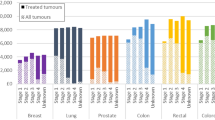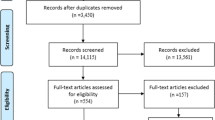Abstract
Objective
To identify the association between multidisciplinary clinic (MDC) management and disparities in treatment for patients with pancreatic cancer.
Background
Socioeconomic status (SES) predicts treatment and survival for pancreatic cancer. Multidisciplinary clinics (MDCs) may improve surgical management for these patients.
Methods
This is a retrospective cohort study (2010–2018) of all pancreatic cancer patients within a large, regional hospital system with a high-volume pancreatic cancer MDC. The primary outcome was receipt of treatment (surgery, chemotherapy, radiation, clinical trial participation, and palliative care); the secondary outcomes were overall survival and MDC management. Multiple logistic regressions were used for binary outcomes. Survival was analyzed using Kaplan–Meier survival analysis, Cox proportional hazards, and inverse probability of treatment weighting (IPTW).
Results
Of the 4141 patients studied, 1420 (34.3%) were managed by the MDC. MDC management was more likely for patients who were younger age, married, and privately insured, while less likely for low SES patients (all p < 0.05). MDC patients were more likely to receive all treatments, including neoadjuvant chemotherapy (OR 3.33, 95% CI 2.82–3.93), surgery (OR 1.39, 95% CI 1.15–1.68), palliative care (OR 1.21, 95% CI 1.05–1.38), and clinical trial participation (OR 3.76, 95% CI 2.86–4.93). Low SES patients were less likely to undergo surgery outside of the MDC (OR 0.47, 95% CI 0.31–0.73) but there was no difference within the MDC (OR 1.10, 95% CI 0.68–1.77). Across multiple survival analyses, low SES predicted inferior survival outside of the MDC, but there was no association among MDC patients.
Conclusion
Multidisciplinary team-based care increases rates of treatment and eliminates socioeconomic disparities for pancreatic cancer patients.


Similar content being viewed by others
References
Lutfi W, Zenati MS, Zureikat AH, Zeh HJ, Hogg ME. Health disparities impact expected treatment of pancreatic ductal adenocarcinoma nationally. Ann Surg Oncol. 2018;25(7):1860–7. https://doi.org/10.1245/s10434-018-6487-5.
Sridhar P, Misir P, Kwak H, et al. Impact of race, insurance status, and primary language on presentation, treatment, and outcomes of patients with pancreatic adenocarcinoma at a safety-net hospital. J Am Coll Surg. 2019;229(4):389–96. https://doi.org/10.1016/j.jamcollsurg.2019.05.027.
Shapiro M, Chen Q, Huang Q, et al. Associations of socioeconomic variables with resection, stage, and survival in patients with early-stage pancreatic cancer. JAMA Surg. 2016;151(4):338–45. https://doi.org/10.1001/jamasurg.2015.4239.
Tohme S, Kaltenmeier C, Bou-Samra P, Varley PR, Tsung A. Race and health disparities in patient refusal of surgery for early-stage pancreatic cancer: an NCDB cohort study. Ann Surg Oncol. 2018;25(12):3427–35. https://doi.org/10.1245/s10434-018-6680-6.
Kirkegård J, Ladekarl M, Fristrup CW, Hansen CP, Sall M, Mortensen FV. Urban versus rural residency and pancreatic cancer survival: a Danish nationwide population-based cohort study. PLoS One. 2018;13(8):e0202486. https://doi.org/10.1371/journal.pone.0202486.
Swords DS, Mulvihill SJ, Brooke BS, Firpo MA, Scaife CL. Size and importance of socioeconomic status-based disparities in use of surgery in nonadvanced stage gastrointestinal cancers. Ann Surg Oncol. 2019. https://doi.org/10.1245/s10434-019-07922-7.
van Roest MH, van der Aa MA, van der Geest LG, de Jong KP. The impact of socioeconomic status, surgical resection and type of hospital on survival in patients with pancreatic cancer a population-based study in the Netherlands. PLoS One. 2016;11(11):e0166449. https://doi.org/10.1371/journal.pone.0166449.
Swords DS, Mulvihill SJ, Brooke BS, Skarda DE, Firpo MA, Scaife CL. Disparities in utilization of treatment for clinical stage I-II pancreatic adenocarcinoma by area socioeconomic status and race/ethnicity. Surgery. 2019;165(4):751–9. https://doi.org/10.1016/j.surg.2018.10.035.
Hoehn R, Rieser C, Winters S, et al. A pancreatic cancer multidisciplinary clinic eliminates socioeconomic disparities in treatment and improves survival. Ann Surg Oncol. 2021;28(5):2438–46. https://doi.org/10.1245/s10434-021-09594-8.
Schiffman SC, Abberbock S, Winters S, et al. A pancreatic cancer multidisciplinary clinic: insights and outcomes. J Surg Res. 2016;202(2):246–52. https://doi.org/10.1016/j.jss.2016.01.021.
UPMC Network Cancer Registry. Accessed December 1, 2022. https://cancerregistrynetwork.upmc.com/upmc-network-cancer-registry/
Area Deprivation Index. Center for Health Disparities Research, University of Wisconsin. Accessed March 1, 2021. https://www.neighborhoodatlas.medicine.wisc.edu
Kind AJ, Jencks S, Brock J, et al. Neighborhood socioeconomic disadvantage and 30-day rehospitalization: a retrospective cohort study. Ann Intern Med. 2014;161(11):765–74. https://doi.org/10.7326/M13-2946.
Hu J, Kind AJH, Nerenz D. Area deprivation index predicts readmission risk at an urban teaching hospital. Am J Med Qual. 2018;33(5):493–501. https://doi.org/10.1177/1062860617753063.
Knighton AJ, Savitz L, Belnap T, Stephenson B, VanDerslice J. Introduction of an area deprivation index measuring patient socioeconomic status in an integrated health system: implications for population health. EGEMS (Wash DC). 2016;4(3):1238. https://doi.org/10.13063/2327-9214.1238.
Newsome SJ, Keogh RH, Daniel RM. Estimating long-term treatment effects in observational data: a comparison of the performance of different methods under real-world uncertainty. Stat Med. 2018;37(15):2367–90. https://doi.org/10.1002/sim.7664.
Carry PM, Vanderlinden LA, Dong F, et al. Inverse probability weighting is an effective method to address selection bias during the analysis of high dimensional data. Genet Epidemiol. 2021;45(6):593–603. https://doi.org/10.1002/gepi.22418.
Young JG, Logan RW, Robins JM, Hernán MA. Inverse probability weighted estimation of risk under representative interventions in observational studies. J Am Stat Assoc. 2019;114(526):938–47. https://doi.org/10.1080/01621459.2018.1469993.
Hernán MA, Lanoy E, Costagliola D, Robins JM. Comparison of dynamic treatment regimes via inverse probability weighting. Basic Clin Pharmacol Toxicol. 2006;98(3):237–42. https://doi.org/10.1111/j.1742-7843.2006.pto_329.x.
Austin PC, Stuart EA. Moving towards best practice when using inverse probability of treatment weighting (IPTW) using the propensity score to estimate causal treatment effects in observational studies. Stat Med. 2015;34(28):3661–79. https://doi.org/10.1002/sim.6607.
AlMasri S, Zenati M, Hammad A, et al. Adaptive dynamic therapy and survivorship for operable pancreatic cancer. JAMA Netw Open. 2022;5(6):e2218355. https://doi.org/10.1001/jamanetworkopen.2022.18355.
Murthy VH, Krumholz HM, Gross CP. Participation in cancer clinical trials: race-, sex-, and age-based disparities. JAMA. 2004;291(22):2720–6. https://doi.org/10.1001/jama.291.22.2720.
Freeman HP. The impact of clinical trial protocols on patient care systems in a large city hospital Access for the socially disadvantaged. Cancer. 1993;72(9 Suppl):2834–8. https://doi.org/10.1002/1097-0142(19931101)72:9+%3c2834::aid-cncr2820721512%3e3.0.co;2-j.
Hasson Charles RM, Sosa E, Patel M, Erhunmwunsee L. Health disparities in recruitment and enrollment in research. Thorac Surg Clin. 2022;32(1):75–82. https://doi.org/10.1016/j.thorsurg.2021.09.012.
Dovey ZS, Nair SS, Chakravarty D, Tewari AK. Racial disparity in prostate cancer in the African American population with actionable ideas and novel immunotherapies. Cancer Rep (Hoboken). 2021;4(5):e1340. https://doi.org/10.1002/cnr2.1340.
Camidge DR, Park H, Smoyer KE, et al. Race and ethnicity representation in clinical trials: findings from a literature review of Phase I oncology trials. Future Oncol. 2021;17(24):3271–80. https://doi.org/10.2217/fon-2020-1262.
NCI. Cancer Health Disparities Research. Accessed April 12, 2022. https://www.cancer.gov/research/areas/disparities
Acknowledgement
This work was funded in part by a grant from the Shadyside Hospital Foundation in Pittsburgh, PA. The funding organization had no role in: the design and conduct of the study; collection, management, analysis, and interpretation of the data; preparation, review, or approval of the manuscript; and decision to submit the manuscript for publication. There are no non-author contributions to disclose. Richard Hoehn had full access to all the data in the study and takes responsibility for the integrity of the data and the accuracy of the data analysis. Mazen Zenati also contributed to data analysis.
Funding
Shadyside Hospital Foundation, Institutional pilot award.
Author information
Authors and Affiliations
Corresponding author
Ethics declarations
Disclosures
These analyses have not been published or submitted elsewhere. The authors have all reviewed this manuscript and approve of this submission. The authors have no disclosures or conflicts of interest.
Additional information
Publisher's Note
Springer Nature remains neutral with regard to jurisdictional claims in published maps and institutional affiliations.
Rights and permissions
Springer Nature or its licensor (e.g. a society or other partner) holds exclusive rights to this article under a publishing agreement with the author(s) or other rightsholder(s); author self-archiving of the accepted manuscript version of this article is solely governed by the terms of such publishing agreement and applicable law.
About this article
Cite this article
Hoehn, R.S., Zenati, M., Rieser, C.J. et al. Pancreatic Cancer Multidisciplinary Clinic is Associated with Improved Treatment and Elimination of Socioeconomic Disparities. Ann Surg Oncol 31, 1906–1915 (2024). https://doi.org/10.1245/s10434-023-14609-7
Received:
Accepted:
Published:
Issue Date:
DOI: https://doi.org/10.1245/s10434-023-14609-7




